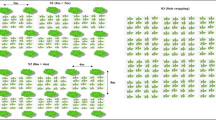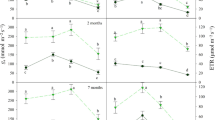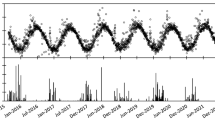Abstract
The objective of the study was to evaluate the productive efficiency of yerba mate regarding growth parameters, subjected to different conditions of cultivation, luminosity, and fertilization. The arboreal component entered to produce shade, corresponding to 60%, 45% and 30% of the light intensity. The luminosity levels were combined with different forms of fertilization: conventional fertilization (CF), controlled-release fertilization (CRF), and unfertilized (UF). The CF and CRF resulted in increase leaf area at 45% and 30% levels of luminosity. The dry weight of the leaves was 9.40% higher using CF, when compared to the unfertilized. Canopy diameter was less sensitive to variations in fertilization but significant in shading, in which the competition limit was described when submitted to 45% luminosity. The height of the yerba mate was homogeneous, and leaf biomass productivity displayed greater efficiency in 60% luminosity, without the use of fertilizer. CF promoted an increment of 8.67% in biomass productivity when under 45% apparent luminosity.


Similar content being viewed by others
References
ABNT: Associação Brasileira de Normas Técnicas (2013) NBR ISO/CIE 8995-1, Rio de Janeiro, RJ, Brazil
Andrade FM (2004) Avaliação de biomassa, clorofila, cafeína e tanino em Ilex paraguariensis Saint-Hilaire, crescendo sob sombreamento e pleno sol., 95 p. Dissertation (Masters in Forest Sciences). Agrarian Sciences Sector, Federal University of Paraná, Curitiba, PR, Brazil
Balbino LC, Cordeiro LAM, Porfírio-da-Silva V, Moraes AD, Martínez GB, Alvarenga RC, Galerani PR (2011) Evolução tecnológica e arranjos produtivos de sistemas de integração lavoura-pecuária-floresta no Brasil. Pesqui Agropecu Bras 46(10)
Caron BO, Dos Santos DR, Schmidt D, Basso CJ, Behling A, Eloy E, Ebamberg R (2014) Biomassa e acúmulo de nutrientes em Ilex paraguariensis A. St. Hil. Ciência Florest 24(2):267–276
Claussen JW (1996) Acclimation abilities of three tropical rainforest seedlings to an increase in light intensity. For Ecol Manag 80:245–255
Fossati LC (1997) Avaliação do estado nutricional e da produtividade de erva-mate Ilex paraguariensis St. Hil., em função do sítio e da dioicia, 113 p. Dissertation (Masters in Forest Sciences)—Federal University of Paraná, Curitiba, PR, Brazil
Galvão F (1986) Variação sazonal da fotossíntese líquida e respiração de Cabralea canjerana (Vell.) Mart., Ilex paraguariensis St. Hil. e Podocarpus lambertii Kl. em função da intensidade luminosa e temperatura. Curitiba, 116 p. Thesis. Doctorate. Federal University of Paraná, Agrarian Sciences Sector, Post-Graduation Course in Forest Engineering
Larcher W (1986) Ecofisiologia Vegetal. Editora Pedagógica e Universitária Ltda., São Paulo, SP, Brazil
Mattos AG (2011) Caracterização das práticas de manejo e das populações de erva-mate (Ilex paraguariensis St. Hil.) nativa em exploração no planalto norte catarinense, 175 p. Dissertation (Masters)—Federal University of Santa Catarina, Florianópolis, SC, Brazil
Mazuchowski J, Silva E, Maccari Junior A (2007) Effect of light and nitrogen on the growth of Ilex paraguariensis St. Hil. Rev Árvore 31(4):619–627
Moraes Neto SP, Gonçalves JDM, Takaki M, Cenci S, Gonçalves JC (2000) Crescimento de mudas de algumas espécies arbóreas que ocorrem na mata atlântica, em função do nível de luminosidade. Rev Árvore 24(1):35–45
Oliveira AC, Weiss D, Pinto LS, Reissmann CB (2001) Procedimentos de coleta para análise foliar de essências florestais (araucária, erva-mate, palmito, eucalipto, pinus). Curitiba: Federal University of Paraná, Solo Planta University Extension Project
Pes L, Hoppe JM, Storck L, Dos Santos Oliveira O (2009) Comportamento da erva-mate (Ilex paraguariensis St. Hil.) em consórcio silvicultural. Ciência Florestal 5(1):9–31
Poletto I, Muniz MFB, DE Ceconi, Mezzomo R, Rodrigues J (2010) Influência da inoculação de Fusarium spp. e níveis de sombreamento no crescimento e desenvolvimento da erva-mate. Ciência Florestal 20(3):513–521
Rakocevic M, Medrado MJS, Lucambio F, Valduga TA (2006) Influência do sexo, da sombra e da idade das folhas no sabor do chimarrão. In: Congreso sudamericano 4; reunión técnica 4 E exposición de agronegocios de la yerba mate 2, Posadas, 2006. Actas… Posadas, Misiones, pp 31–36
Rakocevic M, Janssens M, Schere R (2012) Light responses and gender issues in the domestication process of yerba-mate, a subtropical evergreen. In: Evergreens: types, ecology and conservation, Nova Publishers, New York, pp 63–96
Rossa UB (2013) Produtividade e compostos foliares de erva-mate sob efeitos de luminosidade e fertilização, 207 p. Thesis (doctorate in forest engineering)—Forest Sector, Federal University of Paraná. Curitiba, PR, Brazil
Santin D, Benedetti EL, Reissmann CB (2015) Nutrição e recomendação de adubação e calcário para a cultura da erva-mate. In: Wendling I, Santin D (eds) Propagação e nutrição de erva-mate, Brasília, DF, Brazil, EMBRAPA, pp 99–195
Santin D, Benedetti EL, De Barros NF, De Almeida IC, Wendling I (2017) Intervalos de colheita e adubação potássica influenciam a produtividade da erva-mate (Ilex paraguariensis) no estado do Paraná, PR, Brazil. Floresta 46(4):509–518
Santos SCL (2009) Avaliação comparativa entre sistema agroflorestal com erva-mate e fragmento de Floresta Ombrófila Mista quanto à fitossociologia, parâmetros químicos e físicos do solo e ciclagem de nutrientes, 105p. Dissertation (masters in soil science)—Federal University of Paraná, Curitiba, PR, Brazil
Spolador J, Sanches CMH (2006) Radiação Fotossinteticamente Ativa em uma floresta de transição Cerrado-Amazônica. Rev Bras Meteorol 21(3b):301–307
Taiz L, Zeiger E (2012) Fisiologia Vegetal. Tradução: Armando Molina Divan Junior et al, 5th edn, Porto Alegre: Artmed, 918p
Tonini H, Arco-Verde MF (2005) Morfologia da copa para avaliar o espaço vital de quatro espécies nativas da Amazônia. Pesqui Agropecu Bras 40:633–638
Author information
Authors and Affiliations
Corresponding author
Additional information
Publisher's Note
Springer Nature remains neutral with regard to jurisdictional claims in published maps and institutional affiliations.
Rights and permissions
About this article
Cite this article
Westphalen, D.J., Angelo, A.C., Rossa, Ü.B. et al. Impact of different silvicultural techniques on the productive efficiency of Ilex paraguariensis A.St. Hill. Agroforest Syst 94, 791–798 (2020). https://doi.org/10.1007/s10457-019-00451-y
Received:
Accepted:
Published:
Issue Date:
DOI: https://doi.org/10.1007/s10457-019-00451-y




